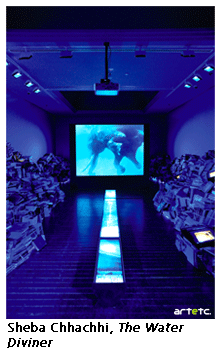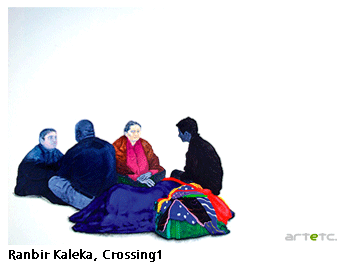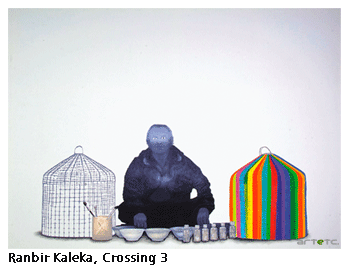- Editorial
- Shibu Natesan Speaks on Protest Art
- Rising Against Rambo: Political Posters Against US Aggression
- Transient Imageries and Protests (?)
- The Inner Voice
- Bhopal – A Third World Narrative of Pain and Protest
- Buddha to Brecht: The Unceasing Idiom of Protest
- In-between Protest and Art
- Humour at a Price: Cartoons of Politics and the Politics of Cartoons
- Fernando Botero's Grievous Depictions of Adversity at the Abu Ghraib
- Up Against the Wall
- Rage Against the Machine: Moments of Resistance in Contemporary Art
- Raoul Hausmann: The Dadaist Who Redefined the Idea of Protests
- When Saying is Protesting -
- Graffiti Art: The Emergence of Daku on Indian Streets
- State Britain: Mark Wallinger
- Bijon Chowdhury: Painting as Social Protest and Initiating an Identity
- A Black Friday and the Spirit of Sharmila: Protest Art of North East India
- Ratan Parimoo: Paintings from the 1950s
- Mahendra Pandya's Show 'Kshudhit Pashan'
- Stunning Detours of Foam and Latex Lynda Benglis at Thomas Dane Gallery, London
- An Inspired Melange
- Soaked in Tranquility
- National Museum of Art, Osaka A Subterranean Design
- Cartier: "Les Must de Cartier"
- Delfina Entrecanales – 25 Years to Build a Legend
- Engaging Caricatures and Satires at the Metropolitan Museum
- The Mesmerizing World of Japanese Storytelling
- The Metropolitan Museum of Art Exhibiting Lyrical Visions: Paintings from North India
- Random Strokes
- Asia Week at New York
- Virtue of the Virtual
- What Happened and What's Forthcoming
- Art Events Kolkata, March – April 2012
- Mumbai Art Sighting
- Art Bengaluru
- Delhi Dias
- Preview, April, 2012 – May, 2012
- In the News, April 2012
- Cover
ART news & views
Transient Imageries and Protests (?)
Issue No: 28 Month: 5 Year: 2012
by Snehal Tambulwadikar
Art, a phenomena which would have never been defined, to label it under any form is marring its versatility. The new media practices in India, also considered 'cutting edge' art, can be a protest in its own way to the traditional art practices. The art practices and their evolution have never been linear, what differentiates these practices from the earlier is the transgression of regular mediums of painting, sculpture and so on. The cutting edge art itself is kind of a protest, liberating from accepted notions of art. The similar practices in India mark diminutive outcomings in contemporary. It is imperative to study these with an open mind, without any prior perceptions withheld.
 The new media practices in India had a late beginning, irrespective of the artist's aesthetics, owing to the late technological advancements in developing countries. The artists, when they began their work, were more akin to experiments in new media rather than the notion of protests, as we find in the developed countries. Thus it would be difficult to judge these practices under the term of protest, though they have the undercurrents of the same, as possessed by all art. Indian society as a whole, being democratic, does not see very obvious protests, like one might find in China. The artists like Pushpamala N., Tejal Shah who use photography to comment on voyeurism, gender issues work essentially on the line of protest, as their imagery protests against the suggestion of visuality in the minds. Sheba Chhachhi on the other hand documents and re-presents the captures moments of identity that one misses when looking at the grand visual. Her works represents persona of females of various strata, occupations, faceless individuals with alternate identities. There are in contemporary more dynamic media, where not the subject/concept matter of the work but the media leads to a notion of transgression. One ponders whether these practices are a deliberate form of protest, and how significant is the media transit in the questioning of histories. We shall have a look at artists like Ranbir Kaleka, who having being worked in the typical paintings, now uses new media like video in combination with painting, and Shilpa Gupta, who experiments with new in every work, using internet, television, photography, as the subject dictates.
The new media practices in India had a late beginning, irrespective of the artist's aesthetics, owing to the late technological advancements in developing countries. The artists, when they began their work, were more akin to experiments in new media rather than the notion of protests, as we find in the developed countries. Thus it would be difficult to judge these practices under the term of protest, though they have the undercurrents of the same, as possessed by all art. Indian society as a whole, being democratic, does not see very obvious protests, like one might find in China. The artists like Pushpamala N., Tejal Shah who use photography to comment on voyeurism, gender issues work essentially on the line of protest, as their imagery protests against the suggestion of visuality in the minds. Sheba Chhachhi on the other hand documents and re-presents the captures moments of identity that one misses when looking at the grand visual. Her works represents persona of females of various strata, occupations, faceless individuals with alternate identities. There are in contemporary more dynamic media, where not the subject/concept matter of the work but the media leads to a notion of transgression. One ponders whether these practices are a deliberate form of protest, and how significant is the media transit in the questioning of histories. We shall have a look at artists like Ranbir Kaleka, who having being worked in the typical paintings, now uses new media like video in combination with painting, and Shilpa Gupta, who experiments with new in every work, using internet, television, photography, as the subject dictates.
 Shilpa, with her works of interactive videos, While I sleep, her multi-armed self photograph referring to the Indian goddess imagery, has been one of leading protagonist in the new media art practices. But does she consider herself as a cutting edge artist? “No,” says Shilpa, “my art was never an intended cutting-edge, it was just an exploration of various mediums as the concept demanded.” Rather Shilpa would not even call her art as protest art, she does not want to consider any categories as at. “Categories become benign,” she believes. Her works are her first reaction to happenings, she addresses the various movements going around.
Shilpa, with her works of interactive videos, While I sleep, her multi-armed self photograph referring to the Indian goddess imagery, has been one of leading protagonist in the new media art practices. But does she consider herself as a cutting edge artist? “No,” says Shilpa, “my art was never an intended cutting-edge, it was just an exploration of various mediums as the concept demanded.” Rather Shilpa would not even call her art as protest art, she does not want to consider any categories as at. “Categories become benign,” she believes. Her works are her first reaction to happenings, she addresses the various movements going around.
 What made her shift to the new media like internet, or television? Shilpa believes that her choice of media is her natural expression, and she has always tried to explore since her college days. She makes use of television as it is part of everyday lives of masses, so is internet. Since all her works are interactive in nature, it seems to be a natural choice. She also prefers to showcase her works in different environments, more so in spaces which offer major public interventions. She wants to awaken the thought buds in the general, why wouldn't she call her art as protest then? Shilpa says that all art questions what happened in past. The works need to be a natural urge to enquiry, which is present in every individual. The initiative to idea/media is a natural drive to push something away, to new openings. Shilpa's works, like the interactive video, do address the issue of text and media together, where figurines of the artist herself are dressed in military dress to shorts, and they move to the text displayed, working like dolls. In another of her works, she has used the self imagery with reference to the multi-armed goddesses of India. While she is dressed in military attire, her four arms in contrast do not hold weapons, but covers her eyes and ears. In more works of this kind are the portraitures of individuals without facial identity, in a mob but portrayed individually. Her works are a strong statement on the violence, also the factor of fear. But yet she does not consider her work as 'protest', “everything is a protest and nothing is, it is the way you look at it.” Rather she does not consider protest as an essential form of art; art is just an exploration. Every generation, irrespective of art, protests with the previous, and it is not accepted easily. But it is not intended protest, even abstract art was considered a grotesque earlier, says Shilpa.
What made her shift to the new media like internet, or television? Shilpa believes that her choice of media is her natural expression, and she has always tried to explore since her college days. She makes use of television as it is part of everyday lives of masses, so is internet. Since all her works are interactive in nature, it seems to be a natural choice. She also prefers to showcase her works in different environments, more so in spaces which offer major public interventions. She wants to awaken the thought buds in the general, why wouldn't she call her art as protest then? Shilpa says that all art questions what happened in past. The works need to be a natural urge to enquiry, which is present in every individual. The initiative to idea/media is a natural drive to push something away, to new openings. Shilpa's works, like the interactive video, do address the issue of text and media together, where figurines of the artist herself are dressed in military dress to shorts, and they move to the text displayed, working like dolls. In another of her works, she has used the self imagery with reference to the multi-armed goddesses of India. While she is dressed in military attire, her four arms in contrast do not hold weapons, but covers her eyes and ears. In more works of this kind are the portraitures of individuals without facial identity, in a mob but portrayed individually. Her works are a strong statement on the violence, also the factor of fear. But yet she does not consider her work as 'protest', “everything is a protest and nothing is, it is the way you look at it.” Rather she does not consider protest as an essential form of art; art is just an exploration. Every generation, irrespective of art, protests with the previous, and it is not accepted easily. But it is not intended protest, even abstract art was considered a grotesque earlier, says Shilpa.


 A conversation with Shilpa Gupta gives a different perspective to look at works of Ranbir Kaleka, who unfortunately was not available for conversation. Ranbir Kaleka does not directly comment on any particular sociale, major of his works re-present the 'seen' with an alternate gaze. With the usage of the painted canvas, and a projected video superseding the same, he makes an interesting visual, as the viewer sees a regular work, and with a sudden flash of bright and noir views, sees the same image in movement, like one finds in Man Threading the Needle. Kaleka's works hold a different dimension for the viewer as in the first place they are timeless. Having worked in the regular 2d medium of paintings, his transition to the new media becomes very interesting. His works are protests in the form of altered gaze, the viewer himself is in dilemma with himself, as to what is seen. In most of his works, Kaleka transgresses the visual by placing the common placed in varied placing at a single occasion. In his work Crossings, the same four individuals transit on four different planes in different screens in a single moment of time. The artist here protests against the regular imagined vision of the audience, while occasional animation adds on to the stillness of the imagery. Same can be observed the video Man with the Cockerel, where we find the man who is struggling to get hold of his cockerel while it runs around. The visual here ignites the audience to see all that is not directly seen in the picture, as Geeta Kapur quotes, 'the rhythmically repeated, soft-gray image offers a tantalizing grasp of desire, an allegory on dispossession, Kaleka's subject-matter is representational and yet, by the form and brevity of its videoed avatar, by a trick of durational fallacy, by sheer transience, it erases its signified meaning. The language of representation enters the luminal zone and the encounter, sanguine, serene, evanescent, resembles a haiku where the hypothesis offered about a lived life needs no backing of proof.' Kaleka in his works contests the notion of living and the lived. But can one consider these attempts under any form of protest, or that the artist intentionally intends to protest for/anti anything. The histories might read it in any form; artist muse might be different, like exploration. Kaleka's works are more of awakening the accustomed visual to transient 'visualities', to nullify the whole, and defy the conclusion.
A conversation with Shilpa Gupta gives a different perspective to look at works of Ranbir Kaleka, who unfortunately was not available for conversation. Ranbir Kaleka does not directly comment on any particular sociale, major of his works re-present the 'seen' with an alternate gaze. With the usage of the painted canvas, and a projected video superseding the same, he makes an interesting visual, as the viewer sees a regular work, and with a sudden flash of bright and noir views, sees the same image in movement, like one finds in Man Threading the Needle. Kaleka's works hold a different dimension for the viewer as in the first place they are timeless. Having worked in the regular 2d medium of paintings, his transition to the new media becomes very interesting. His works are protests in the form of altered gaze, the viewer himself is in dilemma with himself, as to what is seen. In most of his works, Kaleka transgresses the visual by placing the common placed in varied placing at a single occasion. In his work Crossings, the same four individuals transit on four different planes in different screens in a single moment of time. The artist here protests against the regular imagined vision of the audience, while occasional animation adds on to the stillness of the imagery. Same can be observed the video Man with the Cockerel, where we find the man who is struggling to get hold of his cockerel while it runs around. The visual here ignites the audience to see all that is not directly seen in the picture, as Geeta Kapur quotes, 'the rhythmically repeated, soft-gray image offers a tantalizing grasp of desire, an allegory on dispossession, Kaleka's subject-matter is representational and yet, by the form and brevity of its videoed avatar, by a trick of durational fallacy, by sheer transience, it erases its signified meaning. The language of representation enters the luminal zone and the encounter, sanguine, serene, evanescent, resembles a haiku where the hypothesis offered about a lived life needs no backing of proof.' Kaleka in his works contests the notion of living and the lived. But can one consider these attempts under any form of protest, or that the artist intentionally intends to protest for/anti anything. The histories might read it in any form; artist muse might be different, like exploration. Kaleka's works are more of awakening the accustomed visual to transient 'visualities', to nullify the whole, and defy the conclusion.
The cutting edge/new media art as a whole is the protest to regular mediums used, but it is not essential that all artists may do so. Though the idea of transgressing the mediums has led to many artists making use of new media in their works to depict protest. One finds that majority artists today are making use of community sights, documented videos in order to comment on the community itself. The transgression of media is a sign of moving ahead for some, or in some cases, like Shilpa, making use of the medium of common to reach up to them. The attempt to find any linear pattern of evolution in the arts is futile, as it binds the practices of artists, who knowingly/unknowingly want to transcend beyond the prescribed notions. The arts in the oriental become more versatile and transient as they are at a singular time becoming global and trying to relate to the immediate public. The protest here would be fruitful by the acceptance of media for its aesthetics and not the physicality of the same. Contemporary art becomes a protest not just by the media but through the participation of public. The grand narrative is in making, the task is not just being witness but getting into the groove.